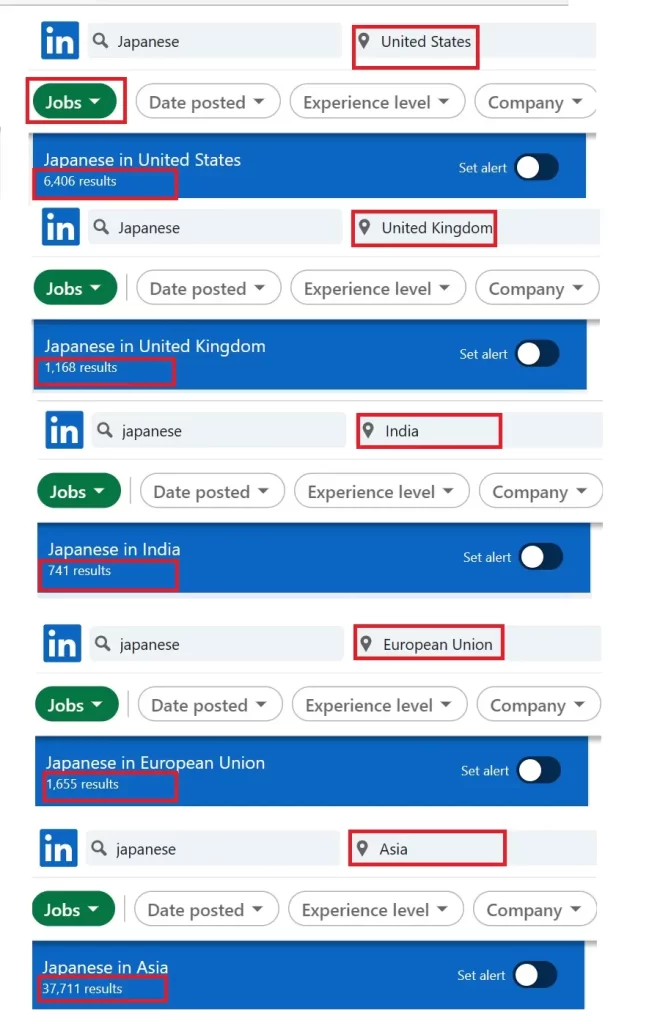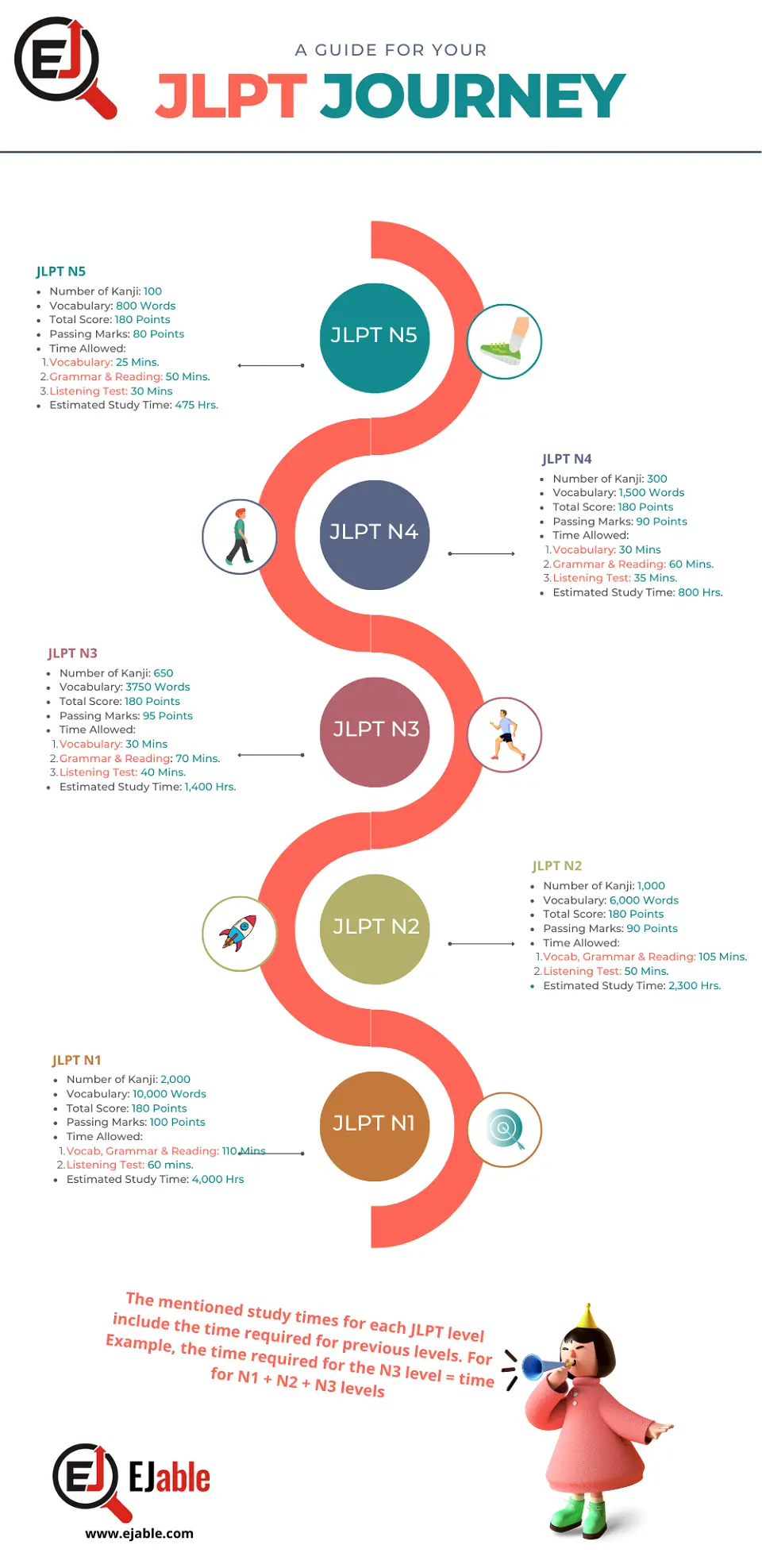How to Prepare for JLPT: Study Guide for JLPT N5 to N1 Levels

JLPT (Japanese-Language Proficiency Test) certifications are important for getting good jobs in Japan and integrating with Japanese life. Therefore, I prepared this detailed step-by-step guide for studying and passing JLPT N5 to N1 levels.
Apart from the tips to prepare for JLPT exams, I have also provided other essential information regarding the JLPT certifications and the tests’ requirements, including an infographic to present all the details visually.
Please note that due to a different sentence pattern of “Subject + Object + Verb” from the “Subject + Verb + Object” structure of English and many other languages, 3 writing scripts (Hiragana, Katakana, and a huge number of complex Kanji characters), at studying for JLPT may look intimidating. However, if you create and follow a well-defined study plan with discipline, you will easily pass JLPT certifications.
While this article discusses JLPT, you may also look at the J Test guide to learn about alternative Japanese language tests.
What is JLPT?
JLPT is the short form for the Japanese Language Proficiency Test (日本語能力試験). JLPT exams evaluate the Japanese language proficiency of non-native Japanese speakers at 5 levels, from beginners to near-native.
The Japanese Language Proficiency Test (JLPT) is the most widely recognized Japanese language test used inside and outside Japan. JLPT certifications are a standard for non-native Japanese speakers who are looking for jobs or entry into university.
The JLPT was started in 1984 by the Japanese Ministry of Education and the Japan Educational Exchange and Services (JEES), and its popularity has been growing continuously since then.
There were just 7019 examinees in 1984. The number of examinees peaked in 2019 at over 1.16 million, precisely 1,168,535.
Due to COVID, the test was conducted only once in 2020, and only 370,028 people took JLPT that year. In 2021, the number of examinees increased again to 684,907. The year 2022 is expected to see more people taking the test, as in July 2022, 356,505 candidates appeared.
There are five levels of the exam: N5 (the lowest) to N1 (the highest). Many people consider JLPT N2 to be the benchmark of Japanese language proficiency.
Many companies often neglect to hire even JLPT N3 or JLPT N4. However, testing for N5 proficiency shouldn’t be a waste of time. For new language learners and those with little Japanese exposure, it’s an easy benchmark to aim for to measure your progress with learning the language.
Is JLPT Only Relevant to Working in Japan?
While JLPT certifications are highly desirable if you wish to live and work in Japan, they can also add value to careers in other countries.
Japanese companies have a presence worldwide. All those companies and other foreign companies that deal with Japanese companies closely need Japanese-speaking people. Such companies require Japanese language proficiency to bridge with native Japanese employees working with Japanese companies.
Have a look at the following screenshots from LinkedIn. This screenshot shows that at any point in time, there are many thousands of jobs available worldwide that require Japanese language skills:

Two other important points to note are as follows:
- Not all jobs are listed on LinkedIn.
- Even if Japanese is not mandatory for some roles, having Japanese skills makes it easier to enter such companies.
The above example shows that JLPT certifications can enhance career options in any developed or developing country, not just Japan.
When are the JLPT Exams Conducted?
JLPT is conducted twice yearly. The schedule may change in a particular year, but mostly, the schedule remains as follows:
| JLPT Schedule | Registration for the Test | Test Schedule | Result Schedule |
|---|---|---|---|
| First Test | Late March to Mid-April | Early July | Around September |
| Second Test | Late August to Mid-September | Early December | Around March |
For more details on schedule, registration, and application details, please check the sites of official test websites of JLPT and JEES.
The following JLPT study guide will discuss all JLPT levels and how to prepare for each level, i.e., from JLPT N5 to JLPT N1 levels. While the following study guide for JLPT also mentions various resources available for each level, you may also refer to this compiled list of online resources for learning Japanese.
You may also like to check out the iOS and Android apps for learning Japanese.
How to Study for the JLPT N5

N5 is the lowest level of the JLPT. To pass JLPT N5, you’ll need to know at least 800 vocabulary words and be able to read hiragana and katakana. Moreover, you need to know at least 80 basic kanji. Please check the JLPT N5 Kanji list.
(Note: You may also like to read our guide to remember Kanji quickly.)
While N5 isn’t anywhere close to fluent in Japanese, it’s a good measure of your ability to understand basic conversational Japanese.
Studying and passing the test shows that you have some foundation in basic functional Japanese. You can greet people and make some sense of the talks, but you can’t express your opinion yet.
Passing the N5 level won’t bring job offers into your inbox. However, it does show your diligence in learning Japanese and your willingness to learn the language.
What they Test for JLPT N5
JLPT N5 tests Japanese reading and listening skills. There aren’t any speaking and writing tests, but I recommend practicing speaking and writing.
This will improve your overall comprehension. JLPT N5 is in a multiple-choice format, with test content related to everyday real-life situations. More exposure to the language will also help you become more familiar with trickier parts of the tests, such as how to use grammar particles and Japanese grammar accurately.
How to Prepare for JLPT N5
Like any standardized test, you’ll want to spend at least three months to prepare for the test. For test-takers who don’t know kanji, you can assume it will take around 450 to 500 hours of study to pass the JLPT N5 test.
Moreover, out of 450 to 500 hours, approximately 150 hours are for learning Kanji. That translates into approximately 2.5 hours of daily studying for 6 months.
There is no one-size-fits-all method of studying for the JLPT. Some students do well with self-study, while others need an extra push from a teacher to really grasp the language. For the N5, there are a variety of textbooks to help prepare you for the test.
The Genki and Yokoso series provide a good foundation as an introduction to Japanese, while the JLPT textbooks serve as good practice for how to take the test.
Reading Sections for the JLPT N5 Level
I would also recommend that test takers prepare by reading Japanese without using Romaji. The test will use Kanji in some parts of the test to challenge your reading ability, and some furigana will be available for help.
There will also be some short reading passages. There will be enough time during the test to read the questions and answers thoroughly, so there’s no need to rush through the test.
Some tests will specifically test for katakana comprehension, and some questions will challenge your knowledge of Japanese grammar. Small mistakes, such as reading ‘ソ’ and ‘ン’ can result in incorrect answers.
Hiragana is commonly used in Japanese text, but katakana is typically used for words from other languages. A good way of practicing katakana is to find lists of loan words and try guessing their meanings.
Be careful; although many of the loan words might sound similar to English, it may surprise you that their meanings are different in Japanese.
For the kanji portion, the test will challenge your ability to read within the context and choose the correct pronunciation. We recommend reviewing on-yomi and kun-yomi readings of the most common basic kanji for the best chance of success.
Listening Section for N5
Neglecting your listening comprehension will hinder your ability to take the JLPT and hamper your ability to communicate in daily life. Japanese pronunciation is fairly simple, but there are some sounds and cadences that English speakers will have difficulty hearing.
While watching Japanese TV shows and movies is a good way to prepare for the test, it’s hard to pick up beginner-level vocabulary and grammar.
Using structured CDs with your course and JLPT textbooks is the best way to prepare for the listening portion of JLPT N5. Other useful listening practices include simple Japanese YouTube channels for N5 learners or podcasts.
Summary of Requirements and Details for JLPT N5
The following table mentions various details and requirements for the JLPT N5 level:
| Item | Details |
|---|---|
| Number of Kanji | 80 Kanji |
| Vocabulary (Number of Japanese words for JLPT-N5) | 800 Words |
| Total Score | 180 Points |
| Minimum Passing Score | 80 Points |
| Time Allowed for JLPT-N5 | Vocabulary: 25 minutes Grammar & Reading: 50 minutes Listening Test: 30 minutes |
| Estimated Study Time for JLPT-N5 (With Kanji) | 450 to 500 hours |
| Estimated Study Time (Without Kanji) | 300 to 350 hours |
What Will You Achieve with JLPT-N5?
Passing the N5 likely won’t help you with any major transition, but it’s a good starting point to measure how much Japanese you’ve been able to learn within 6 months to 1 year.
It also reflects your interest in and seriousness about learning the Japanese language. After all, you paid money to sit through four hours of testing on a Sunday.
Japanese is a difficult language for English speakers, so it’s important to take steps to ease your way into studying and slowly pass more advanced levels of Japanese learning.
Certifying for the N5 level would reflect that you have a good foundation in Japanese and that you’re on your way to the subsequent JLPT levels quicker than you think.
How to Study for JLPT N4

If you’ve passed N5, it might be worth taking the N4 level of the JLPT.
To pass the N4 level, applicants must know at least 300 kanji and 1,500 vocabulary words. Please check the JLPT N4 Kanji list.
While passing N4 likely won’t open any doors for you career-wise, passing the test can measure one’s progress in gaining Japanese proficiency.
Furthermore, it tells the employers about your commitment to learning a new skill. JLPT N4 has three sections to test your Japanese skills: Grammar/Reading and Listening.
Difference Between JLPT N4 & N5
Passing the N4 level isn’t a big hurdle for those who have passed N5. However, applicants need to know about 200 more kanji and around 700 more vocabulary words than those at the N5 level.
Applicants should be more accustomed to seeing commonly used vocabulary words replaced with kanji, such as 読む instead of よむ. The difference is that the JLPT N4 level test does not use Furigana as much as the N5 test.
By the way, Furigana is the hiragana written over the kanji to show the pronunciation. This is especially true for questions specific to kanji pronunciations. One of the books of choice for JLPT N5 is Genki II. This book is also good for moving up to the N3 level after passing the JLPT N4 level.
Study Duration and Resources for JLPT-N4
The approximate number of hours to study for the JLPT N4 level is 775 to 825 hours. Out of these hours, you can assume approximately 240 hours to study the required level of Kanji. Please note that these estimations are only for rough guidance, as the hours you must study vary from person to person.
I would recommend spending at least three months preparing for the test before taking it. Many students proclaim self-study sufficient to pass, but there are structured JLPT classes for those needing an extra push.
The classes focus on all levels of the JLPT. As I mentioned above, the Genki II textbook is helpful because it introduces many helpful vocabulary, grammar, and kanji. For more hands-on preparation for the test, the JLPT textbook series is good practice for taking the test and what to expect in each section.
How to Prepare for the JLPT-N4
As I mentioned above, the JLPT N4 level, like N5, has three sections —Language Knowledge, Grammar/Reading, and Listening.
The questions are straightforward, often asking for details directly related to the reading or listening. Preparing for the knowledge and reading sections will require studies to understand Japanese kanji better.
Learning Kanji radicals and their associated meaning makes memorizing kanji and vocabulary words easier. The radical is often the left-most piece of the kanji, and it’s helpful when looking up kanji in a Japanese dictionary.
For example, you might recognize nichi (日) as the kanji for “day” or “sun”, but it’s also a radical, and many kanji use this character as well.
- 昨 (saku) is the kanji for “previous” and can be combined to write the kanji for yesterday (昨日きのう), pronounced as “kinou” or last year 昨年 さくねん, pronounced as “sakunen”.
- 時 (toki) is the kanji for “time” and can be found in combinations about time, like 時々ときどきor tokidoki, meaning “sometimes.”
- The nichi (日) kanji is also used when talking about the day of the week, i.e., Sunday – 日曜日にちようび or nichiyoubi, and similarly for other days of the week.
As you go deeper into your Japanese learning journey, kanji will become an increasingly important part of that process. There’s no need to memorize long lists of kanji radicals. Instead, study and learn the 51 most common Kanji radicals.
Listening Practice for JLPT N4
While you’ll have a stronger language foundation than N5 applicants, using TV and movies exclusively for listening practice is not recommended.
These programs often have complex vocabulary and grammar, leaving beginners more confused and frustrated than higher-level learners. Thus, we recommend keeping listening practice focused on everyday scenarios, which will likely be the same for the test.
The questions in the listening section will also be fairly straightforward. However, if you want more real-world applications of Japanese at the N4 level, I recommend using material more geared toward young children and beginner Japanese learners—for example, children’s TV shows, movies, and websites like Easy NHK News.
Summary of Study Requirements and Details for JLPT N4
The following table mentions various details and requirements for the JLPT N4 level:
| Item | Details |
|---|---|
| Number of Kanji | 170 Kanji (plus 80 Kanji of JLPT N5) |
| Vocabulary (Number of Japanese words for JLPT-N4) | 1,500 words |
| Total Score | 180 Points |
| Minimum Passing Score for JLPT-N4 | 90 Points |
| Time Allowed for JLPT-N4 | Vocabulary: 30 minutes Grammar & Reading: 60 minutes Listening Test: 35 minutes |
| Estimated Study Time for JLPT N4 (With Kanji) | 775 to 825 hours |
| Estimated Study Time for JLPT-N4 (Without Kanji) | 535 to 585 hours |
What Will You Achieve with JLPT N4?
Like the N5, passing the N4 will not bring many job offers to your inbox. However, it will build the foundation for your future fluency pathway.
Employers will likely see it as a commitment you’ve taken towards becoming better at your job and having the ability to live in Japan. Mastering the N4 level shows that you have a foundation in Japanese and the potential to learn further.
How to Study for the JLPT N3

The JLPT N3 level is the upper-intermediate level of the JLPT, and passing the N3 level signifies a good command of basic Japanese grammar and vocabulary.
You’ll need to know a minimum of 650 kanji and 3,750 vocabulary words for test applicants at this level.
This is almost double the requirement for JLPT N4. As the midway point of the JLPT, passing the N3 can be a reasonable goal for Japanese learners, especially for those wanting to test their Japanese abilities used in everyday situations.
Although many employers only consider N2 & N1 as signifiers of advanced Japanese proficiency, there are some opportunities where the N3 is good to strengthen your resume and show your progress toward language comprehension.
Opportunities include roles where communication is not essential to carry out tasks. Examples of tech jobs are product engineering services, e-engineering, and embedded systems. In contrast, higher Japanese proficiency is necessary if you are in a business consulting role or even a functional ERP consulting role.
Difference between JLPT N4 & N3
The gap between N4 and N3 is substantial. Test applicants need to know 650 kanji and about 3,750 vocabulary words to pass the test, almost double the number of kanji and vocabulary required for the N3.
While those numbers seem high for non-native speakers, the linguistic capabilities of an N3 test applicant are comparable to those of a high-level Japanese elementary school student. The JLPT N3 level tests your ability to comprehend basic Japanese rather than the specific meanings or readings.
JLPT N3 test will test your ability to read kanji in context. Moreover, the questions in the reading section will require more critical thinking skills to answer correctly.
Details of JLPT-N3 Test and Tips
There are three main sections of the N3 test— Language Knowledge (Vocabulary), Language Knowledge (Grammar), and Reading and Listening.
The vocabulary and grammar will cover basic nouns and verbs from N4 and N5 and slightly more complex terms to read materials like short stories and newspaper headlines.
Test takers should also be comfortable with typical grammar points such as particle placements, causal and formal conjugations, and past and present tense forms.
THE JLPT N3 test is 140 minutes with an overall score of 180 points. To pass the test, you must score a minimum of 95 points total, with a minimum of 19 points for each section.
For many test-takers, vocabulary, and grammar will create the most difficulty in transitioning from beginner to intermediate-level Japanese.
While many sites will create lists of required grammar and vocabulary to know, we recommend, at this point, learning more through context. This will help expose you to more natural patterns in Japanese. Moreover, it will also judge and see how complicated vocabulary you used.
For example, both ~代わりに and ~にかわって are used to express alternatives and can both be translated to mean “instead of.” However, the usage and nuance of both terms are slightly different.
- 代わりに can be used with nouns, verbs, and adjectives, and its usage carries the meaning of doing one thing over something else. For example, 今日は歩き代わりに電車に乗った。 (Today, I took the train instead of walking.)
- ~にかわって is only used with nouns and is often used to express someone doing something on behalf of another person. For example, 兄はお父さんににかわって車を洗った。 (My brother washed the car for my dad.)
As you continue to prepare for the JLPT, it’s important to remember that Japanese is a very context-heavy language. Understanding the nuance rather than only the translation will further your studies.
How to Prepare for JLPT N3
The estimated study time for the N3 preparation is around 1,325 to 1,500 hours. And that comes to about 3 hours of effort every day for a year.
Course textbooks are always good to help slowly introduce new vocabulary and grammar. Textbooks like An Integrated Approach to Intermediate Japanese help comprehensively bridge basic and intermediate Japanese.
The Kanzen Master textbook series is also a great way to prepare for the test and what sort of questions you can expect on the test.
For the listening section, exposure to native speakers will benefit you for the test. The CD from your textbook will be a great starting point for practice, but I also recommend using more outside materials such as YouTube videos, podcasts, etc.
While you won’t be able to read young adult novels, we recommend incorporating more real-world Japanese materials into your practice sessions.
Manga and shows aimed at children should be easy enough for you to understand the plot while challenging you with more vocabulary. EasyNHK is an excellent site that Japanese elementary students use to help them understand the news. The site shows shortened versions of real news from the official NHK news site.
Other useful tools and websites include SatoriReader, the Easy Japanese Matcha Japan website, and Memrise.
Summary of Requirements and Details for JLPT N3 Test
The following table mentions various details and requirements for the JLPT N3 level:
| Item | Details |
|---|---|
| Number of Kanji | 370 Kanji (plus 250 Kanji of JLPT N5 and N4) |
| Vocabulary (Number of Japanese words for JLPT-N3) | 3,750 words |
| Total Score | 180 Points |
| Minimum Passing Score | 95 Points |
| Time Allowed for JLPT-N3 | Vocabulary: 30 minutes Grammar & Reading: 70 minutes Listening Test: 40 minutes |
| Estimated Study Time for JLPT-N3 (With Kanji) | 1,325 to 1,500 hours |
| Estimated Study Time (Without Kanji) | 900 to 1,075 hours |
What Will You Achieve with JLPT N3?
Passing the N3 level shows that you have a basic knowledge of Japanese.
Moreover, it signifies that you didn’t stop learning after the first two levels, which makes the positive impression that you’re well on your way to a higher level of Japanese fluency.
Although N2 is the threshold for fluency, more companies are relaxing their standards for Japanese fluency to the N3 level. Some managerial teaching positions and roles in recruitment, marketing, and business development are opening up to N3 test takers.
So, remember to keep studying. You’ll be fluent before you know it.
How to Study for the JLPT-N2

The N2 level is the upper-intermediate to advanced level of the JLPT. Passing it signifies that you have a good command of basic Japanese and can understand more complex subjects.
Unlike the previous three levels of JLPT, where the gap between each level seemed relatively small, making the leap from JLPT N3 to N2 needs more effort.
Grammar and vocabulary become more complex, especially as you discover hidden meanings from previously learned words and even start to learn the more complex Chinese readings and origins of words.
If you look forward to working in Japan, the N2 certification will be great to have on your resume. Unarguably it will enhance your chances of getting a job and your career growth in Japan.
Difference between JLPT N3 & N2
Fortunately, for the JLPT N2, test takers only need to know about 1,000 kanji, about 400 more than the kanji requirement for the N3 level. However, the vocabulary for N2 consists of about 6,000 words—about 2,500 more than the N3 level.
Although all the above-mentioned requirements may sound daunting at first, it’s important to remember that all the vocabulary, kanji, and grammar are widely used in native Japanese. The linguistic capabilities of both levels are also pretty different.
The linguistic abilities of test-takers here will be around the level of a Japanese junior high school student. Therefore, questions will be less straightforward. Especially in the reading portion, you’ll need to rely on context to come to logical conclusions about the passages you’ll be reading.
Details of JLPT N2 Test and Tips
The JLPT N2 level has three sections: language knowledge, reading comprehension, and listening comprehension.
Each section of the N2 level has 60 points, with 180 points for the entire test. Therefore, the minimum passing score is 90, and you’ll need 30 points in each section to pass.
JLPT N2 test will be similar to the N3. However, the integrated comprehension questions in the reading section will be new to this level.
You’ll read two or three passages; for these questions, you’ll have to compare and contrast the readings on the topic they cover. The listening portion will also be at a more native level of speaking about more complex topics.
Moreover, it will also incorporate more usage of keigo, meaning honorific speech. Rather than simple answers like the previous three tests, you’ll need to make inferences about the dialogue or solve the problem the test asks for.
How to Prepare for JLPT N2
The approximate hours to prepare for the JLPT N2 level is 2,200 to 2,400 hours. Out of these hours, you can assume approximately 725 to 750 hours to study the required numbers of Kanji.
You’ll need to take a more integrated approach to learning Japanese, especially at this Japanese prep and study stage, rather than remote vocabulary memorization.
Tobira is a good textbook for learning more specific vocabulary and an introduction to new grammar compared with previous grammar. It’s also essential to note words with similar meanings and kanji and how to use those.
For example, 変化 and 変更 both mean “change,” but 変更 refers explicitly to a change by humans. 変化 is used to refer to change in general. Please check the following examples:
- 社会問題に対する考え方は、年齢を重ねるごとに変化する。 (Your views on social issues will change as you get older.)
- 政府は教育方針を変更せざるを得なかった。 (The government had to change its education policy.)
Frequent exposure to native Japanese will be the best strategy to pass the test. For reading comprehension, you’ll have several passages to read through.
Moreover, you’ll have to be able to read them fairly quickly while also summarizing the material. Sites like Easy NHK are a good starting point for practicing reading and summarizing while accessing the adult version to gain more vocabulary and grammar.
Other suggestions we recommend are fiction and nonfiction children’s novels. The Kanzen Master series for N2 can also help you build up your vocabulary and grammar while preparing for the test.
Listening Practice for JLPT N2 – Suggestions
The JLPT N2 test expects you to be near the business level of fluency.
Therefore, the listening portion will be a lot closer to native speed. The topics will vary in this section and could range anywhere from dialogues between a group of people to the summary of a news topic.
We recommend incorporating as much native listening practice as possible into your Japanese study schedule. Podcasts like Small Talk in Japanese or HikiBiki are good for everyday banter with some challenging vocabulary. Adding drama and music is also okay, but avoid slang and wonky pronunciation.
Summary of Requirements and Details for the JLPT N2 Test
The following table mentions various details and requirements for the JLPT N2 level:
| Item | Details |
|---|---|
| Number of Kanji | 380 Kanji (plus 620 Kanji of JLPT N5 to N3) |
| Vocabulary (Number of Japanese words for JLPT-N2) | 6,000 words |
| Total Score | 180 Points |
| Minimum Passing Score | 90 Points |
| Time Allowed for JLPT-N2 | Vocabulary, Grammar & Reading: 105 minutes Listening Test: 50 minutes |
| Estimated Study Time for JLPT-N2 (With Kanji) | 2,200 to 2,400 hours |
| Estimated Study Time for JLPT N2 (Without Kanji) | 1,475 to 1,525 hours |
What Will You Achieve with JLPT N2?
Passing the JLPT N2 is a fantastic accomplishment only a minority of non-native Japanese speakers can achieve.
While it doesn’t prove complete fluency in Japanese, it shows your dedication and hard work in learning Japanese. For those planning on attending school or making a career in Japan, this is just one step toward making dreams come true.
How to Study for the JLPT-N1

Passing the N1 level is often seen as the top goal for Japanese language learners. Many Japanese language programs offer courses to pass the JLPT N1 test.
While many people often stop at the JLPT-N2 level of certification, there are some benefits to passing the N1 level. More is always better, especially for skills, knowledge, and experiences.
Why Take JLPT-N1
The N2 and N1 levels are the most challenging of the JLPT Certifications. However, while the N2 level does signify some advanced fluency, passing the N1 level has some merit.
The highest level of Japanese language certification represents your dedication to learning the language and Japanese culture. Passing the JLPT N1 gives some extra points to those who hope to start their own business in Japan or obtain citizenship, which makes the process smoother.
While the N2 is often the lowest requirement for many jobs and schools requiring foreign applicants, the JLPT N2 test is about the same level as a Japanese middle school student linguistically.
Details of JLPT N1 Test
The N1 test has two main sections: Listening and Language Knowledge (Grammar and Reading). For the test, you’ll need to know about 10,000 vocabulary words.
You must also know 2000 kanji, twice as many kanji, and vocabulary as the N2 level. Test takers must also prepare to understand Japanese at an abstract level. It means that test takers need to understand the tone of what is being said.
How to Prepare for the JLPT N1
The approximate time to prepare for the JLPT N1 is 3,900 to 4,100 hours. Out of these hours, you can assume approximately 1,750 to 1,850 hours to study the required Kanjis.
Much like the N2, more exposure to real-world Japanese will be the best way to prepare for the N1 level. With the high kanji level, vocabulary and grammar featured on the test.
I recommend studying Japanese through context rather than memorizing the particular meaning of every single word. Especially since many words at the upper level have similar meanings, you’ll need to understand the nuance of what you’re reading.
One example is 権限 vs. 権威.
These words are pronounced differently (kengen and keni), but they both mean “authority.” Kengen refers to the power given by an authority figure. On the other hand, keni refers to a person in an organization or field with power.
- 彼を解雇する権限をくれた。 (He gave me the authority to fire them.)
- 彼は権威がある男です。 (He is a man of authority.)
Reading newspapers and magazines will be extremely helpful for the N1 since most of the reading will be short passages pulled from those sources. Japanese news articles can easily be accessed through sites like NHK, Asahi Shimbun, etc.
For more detailed explanations of grammar, the Kanzen Master series provides a good overview and practice for the different grammar points you’ll likely encounter on the test.
While difficult to read in a second language, novels are another good source of materials to familiarize yourself with for exposure to more classical Japanese. In addition, bilingual translation books such as Furigana Japan or Japanese short stories will help with pattern recognition.
Suggestions for Listening Practice for N1 Level of JLPT
There are no hard or fast rules for preparing for the listening portion of the N1 test. It can feature anything from conversations between a group of people to a summary of a story.
The most important skill you’ll need for the listening portion is holding Japanese in your head. You’ll only be able to hear the listening quiz once, and the questions will come directly after.
Aside from using listening materials, many Japanese teachers recommend thinking in Japanese independently. Have conversations in Japanese and do everyday tasks in Japanese to boost your listening skills and comprehension before the test.
Summary of Study Requirements and Details for the JLPT N1 Test
The following table mentions various details and requirements for the JLPT N1 level:
| Item | Details |
|---|---|
| Number of Kanji | 1,136 Kanji (plus 1,000 Kanji of JLPT N5 to N2) |
| Vocabulary (Number of Japanese words for JLPT-N1) | 10,000 words |
| Total Score | 180 Points |
| Minimum Passing Score | 100 Points |
| Time Allowed for JLPT-N1 | Vocabulary, Grammar & Reading: 110 minutes Listening Test: 60 minutes |
| Estimated Study Time for JLPT-N1 (With Kanji) | 3,900 to 4,100 hours |
| Estimated Study Time (Without Kanji) | 1,750 to 1,850 hours |
What Will You Achieve with the JLPT N1 Level?
Passing the JLPT N1 is an extraordinary accomplishment only a small group of non-native Japanese speakers can achieve.
Passing the test shows your dedication to the Japanese language and culture. And it opens up opportunities for you both inside and outside Japan. For those who intend to make a career in Japan, JLPT N1 certification would make you closer to success.
Summary of JLPT Preparation, including the Infographic
To help you study, the summary requirements of the JLPT certifications for all levels are as per the following table:
| JLPT Level | Total Number of Kanji | Vocabulary (No. of Words) | Study Time Estimation (Including Kanji) | Time Allowed for Test (In minutes) | Points to Pass |
|---|---|---|---|---|---|
| N5 | 80 | 800 | 475 Hours | Vocabulary: 25 Grammar/Reading: 50 Listening: 30 | 80 out of 180 |
| N4 | 250 | 1,500 | 800 Hours | Vocabulary: 30 Grammar/Reading: 60 Listening: 35 | 90 out of 180 |
| N3 | 620 | 3,750 | 1,400 Hours | Vocabulary: 30 Grammar/Reading: 70 Listening: 40 | 95 out of 180 |
| N2 | 1,000 | 6,000 | 2,300 Hours | Vocabulary, Grammar & Reading: 105 Listening: 50 | 90 out of 180 |
| N1 | 2,136 | 10,000 | 4,000 Hours | Vocabulary, Grammar & Reading: 110 Listening: 60 | 100 out of 180 |
Note: The above table mentions the total number of Kanji characters for various levels of JLPT. Please note that these numbers include the Kanji of the previous levels. You may also wonder why JLPT N1 has 2,136, not 2,000 or 2,100 or 2,200. The reason is that 2,136 is the total number of Jōyō Kanji (常用 漢字), or daily use Kanji.
Please also note that while each level of JLPT has a fixed number of Kanji characters to remember, please do not forget to review all the Kanji of the previous levels of JLPT as those are included in the tests.
The following infographic summarizes all details, including the study guide for all levels of JLPT, i.e., from JLPT-N5 to JLPT-N1:

Final Tips for Studying for JLPT and Passing with Flying Colors
- Studying and mastering all the JLPT levels till N1 is a long journey. Unlike other educational qualifications, most of us study JLPT in our spare time with jobs or other formal courses. That makes having a detailed plan with a schedule and goals broken down daily or at least weekly crucial.
- Studying and remembering Kanji is one of the most crucial parts of passing all JLPT levels. As Kanji is pictorial, even if, over time, the shapes change, there is always a logic or picture as the base of the Kanji. If the origin of the Kanji character does not help, use mnemonics.
- Keep some time for practice in your preparation schedule by taking JLPT mock tests. You can use sample questions and the official workbooks from the JLPT website. Some other resources are Japanese Quizzes for online mock tests, Test Mocks, and Attain Online Japanese.
- Practice speaking Japanese as much as possible. After all, during an interview, the employer would like to see your level of spoken Japanese.
- While passing any JLPT level is an achievement, focusing on higher marks is crucial. Passing with 50% marks is as good as succeeding at 50% of that level.
- Skip the hard questions and go for answering the easy ones first. Every JLPT certification test has a time limit; answering as many questions as possible is vital.
- During listening comprehension tests, you must finish listening and answer the questions. It is important to jot down notes while listening so that you can refer to them while answering the questions.
- It is better to disqualify the wrong choices for multiple-choice JLPT questions first than to find the correct one.
You may also like to read articles about useful Japanese phrases and common Japanese greetings.

Jamila Brown is a 5-year veteran in Japan working in the education and business sector. Jamila is currently transitioning into the digital marketing world in Japan. In her free time, she enjoys traveling and writing about the culture in Japan.
